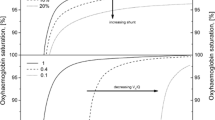Abstract
There is an extensive literature on methods for discriminating between an increased shunt and a reduced ratio of ventilation to perfusion. In this review we prefer the terms “VA/Q” and “reduced or low VA/Q” rather than “V/Q inequality” to refer to the effects on arterial oxygenation of reducing V/Q below 0.8 to about 0.1. Almost without exception the conventional methods for measuring shunt and reduced VA/Q are invasive as well as technically complex. For most clinicians who are dealing with a hypoxemic patient the relevance of these entities is not so obvious as to justify the time and difficulty in either understanding or measuring them. However this review shows that, while an increased shunt and a decreased VA/Q both reduce arterial oxygen saturation (SaO2) at a particular inspired oxygen concentration (PIO2), the effect of shunt and reduced VA/Q have important clinical differences on the relationship between PIO2 and SaO2. The review also outlines a simple non-invasive method for measuring shunt and reduced VA/Q which illustrates the value of discriminating between them in clinical practice.
Similar content being viewed by others
REFERENCES
Dantzker DR, Wagner PD, West JB. Instability of lung units with low VA/Q ratios during O2 breathing. J Appl Physiol 1975; 38: 886–895
Browne DRG, Rochford J, O'Connel W, Jones JG. The incidence of postoperative atelectasis in the dependent lung following thoracotomy: The value of added nitrogen. Br J Anaesth 1970; 42: 340–346
Benatar SR, Hewlett AM, Nunn JF. The use of iso-shunt lines for control of oxygen therapy. Br J Anaesth 1973; 45: 711–718
Benumof JF. Respiratory physiology and respiratory function during anesthesia. In: Miller RD, ed., Anesthesia (Volume 2). New York: Churchill Livingstone, 1986:1115–1163
Zetterstrom H. Assessment of the e¤cacy of pulmonary oxygenation. The choice of oxygenation index. Acta Anaesth Scand 1988; 32: 579–584
Sapsford DJ, Jones JG. Predicting changes in oxygen saturation using pulse oximetry. Br J Anaesth 1988; 61: 497P
Sapsford DJ, Jones JG. Derivation of V/Q from the position of the PIO2 vs. SpO2 curve. Br J Anaesth 1992; 69: 541P
Sapsford DJ, Jones JG. The PIO2 vs. SpO2 diagram: A non-invasive measure of pulmonary oxygen exchange. Eur J Anaesth 1995; 12: 375–386
Roe PG, Jones JG. Analysis of factors which a¡ect the relationship between inspired oxygen partial pressure and arterial oxygen saturation. Br J Anaesth 1993; 71: 448–494
Roe PG, Jones JG. Causes of oxyhaemoglobin saturation instability in the post operative period. Br J Anaesth 1993b; 71: 481–487
Lawler PGP, Nunn JF. A reassessment of the validity of the iso-shunt graph. Br J Anaesth 1984; 56; 1325–1335
de Gray L, Rush EM, Jones JG. A non-invasive method for evaluating the e¡ect of thoracotomy on shunt and ventilation perfusion inequality. Anaesthesia 1997; 52: 630–635
Burnstein RM, Newell JP, Jones JG. Sequential changes in gas exchange following traumatic fat embolism. Anaesthesia 1998; 53: 369–381
Powell JF, Kelsall AWR, Jones JG. Non-invasive assessment of virtual shunt and low V/Q in neonates with pulmonary failure. Br J Anaesth 1996; 76 (Suppl 2): 94
Dueck R. Gas exchange. In: Jones JG, ed. E¡ects of anesthetics and surgery on pulmonary mechanisms and gas exchange. Boston: Little Brown and Co., 1984: 13–24
Olszowka AJ, Wagner PD. Numerical analysis of gas exchange in pulmonary gas exchange (Volume 1). Academic Press, Inc., 1980: 263–306
Edwards AD, Wyatt JS, Richardson C, Delpy DT, Cope M. Cotside measurement of cerebral blood flow in ill newborn infants by near infrared spectroscopy. Lancet 1988; ii: 770–771
Hand IL, Shepard EK, Krauss AN, Auld PAM. Ventilation-perfusion abnormalities in the preterm infant with hyaline membrane disease: A two compartment model of the neonatal lung. Ped Pulmonology. 1990; 9: 206–213
Entwistle MD, Roe PG, Sapsford DJ, Berrisford RG, Jones JG. Patterns of oxygen saturation after thoracotomy. Br J Anaesth 1991; 67: 704–711
Catley DM, Thornton C, Jordan C, Lehane JR, Jones JG. Pronounced episodic oxygen desaturation in the post operative period: Its association with ventilatory pattern and analgesic regimen. Anesthesiol 1985; 63: 20–28
Wheatley RG, Somerville ID, Sapsford DJ, Jones JG. Postoperative hypoxaemia: Comparison of extradural, IM, and patient controlled opioid analgesia. Br J Anaesth 1990; 64: 267–275
Smith HL, Sapsford DJ, Jones JG, Delaney ME. Hypoxaemia in patients with severe coronary artery disease. Anaesthesia 1996; 51: 211–218
Roe PG, Gadelrab R, Sapsford D, Jones JG. Intra-operative gas exchange and post-operative hypoxaemia. Eur J Anaesth 1998; 14: 203–210
Powell JF, Menon DK, Jones JG. The e¡ects of hypoxaemia and recommendations for post operative oxygen therapy. Anaesthesia 1996; 51: 769–772
Author information
Authors and Affiliations
Rights and permissions
About this article
Cite this article
Jones, J.G., Jones, S.E. Discriminating Between the Effect of Shunt and Reduced VA/Q on Arterial Oxygen Saturation is Particularly Useful in Clinical Practice. J Clin Monit Comput 16, 337–350 (2000). https://doi.org/10.1023/A:1011495416005
Issue Date:
DOI: https://doi.org/10.1023/A:1011495416005




